
Search
Posts con la etiqueta ‘Costa Rica’
UNGA 2019 | MPPN Side Event ‘Call for action: Using multidimensional poverty indices to lead progress in the SDGs’
Highlights from the discussion included:
Eminent speakers
 H.E. Carlos Alvarado, President of Costa Rica
H.E. Carlos Alvarado, President of Costa Rica
“We started this path on 2014, and before that we were just measuring poverty by income, but what’s the problem of measuring poverty only by income? It’s a consequence, income is a consequence of the reality of people. So you do not really know what are the interlinked deprivations.”
“It is very important for every country to invest constantly in scientific and impartial data analysis.”
“When we developed this we worked with each minister of the cabinet that had something to do with this dimension so that the indicators were relevant for their work. Each indicator you can address with public policy. When you measure poverty only by income it’s everybody’s fault and nobody’s fault. When you measure poverty through specific indicators, you have a ministry of housing, you have a ministry of science and technology, a ministry of health, a ministry of labour, a ministry of education so those indicators are their indicators as well. This will allow you to have clear departure points and you can see your progress through time in the different variables. You can budget specifically in each dimension…and measure improvement to see if you can accomplish goals.”
“We launched in 2015, and it has been ground-breaking and has changed the paradigm in which we see poverty in Costa Rica.”
“What we see as the second generation, is …. administrative registration data… In Costa Rica we have a unique … living census to which you can apply multidimensional analysis…to tackle poverty directly not only by income, but by each of their dimensions.”
“We use a lifecycle approach…this means I asked the guys working there to show me the latest report of how many pregnant women there are in Costa Rica, and they showed me the current pregnant women in Costa Rica. It was approximately 50,000. I said ok, from that info, show me which of those women are in poverty. It was 40%, in extreme poverty – 10%. Of that 10%, show me which are 15-19, and it was about 300 pregnant women. We know them by name and address, so you can address a specific public policy to those future citizens which are going to be the most vulnerable, which means you can start building human capital before the child has even reached the earth.”
“We know all the households in extreme poverty which are not in any programme, those 37,000 are our next step, we know how to identify them, we can go directly to where the most poor and vulnerable people are, not only with cash transfer programmes but programmes in all dimensions to build human capital.”
OPHI is “a great team around the world and a great network around the world”.
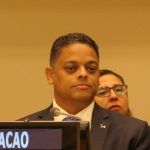 H.E. Eugene Rhuggenaath, Prime Minister of Curaçao
H.E. Eugene Rhuggenaath, Prime Minister of Curaçao
“To complement our work by including the voices and insights of the poor, we conducted a multidimensional poverty pilot survey in a neighbourhood, prior to delivering family-focused interventions. That programme has now been expanded into a broader social development agenda for the next two years, including family assistance and coaching and workforce development.”
“I welcome the efforts of the Seychelles, [to] focus on SIDs developing national MPIs… the way that SIDS experience poverty is often … very different than the way it is experienced in larger countries. National MPIs help us to see and effectively manage our different definitions of poverty”.
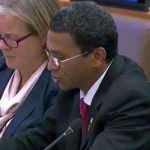 H.E. Barry Faure, Secretary of State for Foreign Affairs and the Blue Economy, Seychelles, delivering a message on behalf of H.E. Danny Faure, President of Seychelles
H.E. Barry Faure, Secretary of State for Foreign Affairs and the Blue Economy, Seychelles, delivering a message on behalf of H.E. Danny Faure, President of Seychelles
“Seychelles launched its pilot national Multidimensional Poverty Indices on 1st July this year, becoming the second High Income Country in the world after Chile to use the MPIs. We found that a multidimensional measure far better reflects the distinctive characteristics of poverty in our Islands. It allows us to analyse the pockets of poverty that exist in Seychelles, so that we can target interventions accordingly.”
“Later this year, the MPIs will become an official statistic of the government to inform policymaking, monitor progress in eradicating poverty, and be reported against Goal 1 of the SDGs.”
“The global MPI can play a critical role in ensuring no one is left behind. This is a people-centered index that reflects poverty as poor people often describe it, and captures the multiple deprivations the less fortunate face at the same time.”
“In July this year, Seychelles hosted the annual Meeting of the 58-country Multidimensional Poverty Peer Network, where we discussed how MPIs can accelerate progress towards SDG 1: No Poverty. As a community, we agreed to advocate for several critical points:”
“Firstly, although many countries have or are building MPIs, as yet no country can report their SDG indicators in the global database. So since 2015, even countries that update their MPI annually – such as Colombia – have not been permitted to upload their MPI into the global database. We request UN Statistics Division to address this matter urgently, and also request UNDP to consider being the custodian agency, so that countries are able to report on this important issue.”
“The second point: We propose that the global MPI be included as an indicator in SDG 1 to track global trends in non-monetary poverty. It seems odd that, while the SDGs address poverty in all its forms and dimensions, there is no indicator of multidimensional poverty alongside the $1.90/day measure.”
“We are pleased to note that the Global Sustainable Development Report uses the global MPI that UNDP and OPHI compute for this purpose. We call on this to be included in the Secretary General’s report each year on Goal 1, so that we can see how multidimensional poverty is changing at a global scale, and celebrate our success in 2030.”
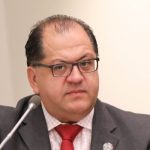 Luis Felipe Lopez Calva. Regional Director for Latin America and the Caribbean, UNDP delivering a message on behalf of Achim Steiner, Administrator, United Nations Development Programme
Luis Felipe Lopez Calva. Regional Director for Latin America and the Caribbean, UNDP delivering a message on behalf of Achim Steiner, Administrator, United Nations Development Programme
“We are at the four-year mark of the adoption of the 2030 Agenda for Sustainable Development.”
“As embodied in that agenda, “We learned that growth is uneven and volatile, and that well-being goes far beyond income. We recognized that while income is a necessary condition, it is by no means a sufficient one to secure well-being. We agreed that a monetary measure of poverty is not enough – we need to understand also the depth, persistence and complexity of poverty.”
“After a journey that UNDP supported since the beginning of this century and after a very close partnership fostered with Dr Sabina Alkire and Professor James Foster and others, next year will be 10 years since UNDP and OPHI first launched what was at the time the Multidimensional Poverty Index.
“While this index was originally received with trepidation from the development community, almost a decade later we can be certain that the thinking of development actors has converged towards this multidimensional approach. We have witnessed how the Index has triggered rich discussion among policy makers and development practitioners around the world.”
“Prior to that, UNDP was also the first to champion the reconceptualization of well-being beyond income, with its publication of the Human Development Index in the nineties. With it, it solidified the notion that progress meant much more than economic growth.”
“Arguably, the 2030 Agenda can be interpreted as the political consolidation of these different ways to think about development”
“To conclude, let me make two additional points: First, the Multidimensional Poverty Index has helped to improve our understanding of poverty in many countries.
“Second, the Multidimensional Poverty Index is an instrument for enhancing governance, acting as a policy coordination tool that encourages different sectors to align behind a common goal. Moreover, it fosters government accountability—as it allows progress to be widely scrutinized, lagging dimensions identified, and successes celebrated.”
“As we have done since the very beginning, UNDP reiterates its commitment to support the multidimensional approach to poverty and the MPI.”
Ministerial Discussion
 H.E. Teodoro Ribera Neumann, Minister of Foreign Affairs, Chile
H.E. Teodoro Ribera Neumann, Minister of Foreign Affairs, Chile
“In 2012, President Sebastián Piñera created the Presidential Advisory Commission for the Measurement of Poverty during his first presidential term. That commission recommended installing the Multidimensional Poverty Measurement in Chile as a complement to the Income Poverty Measurement. As a result of the recommendation, in December 2014, the Ministry of Social Development and Family determined its first Multidimensional Poverty Index (IPM) officially based on the methodology proposed by Alkire & Foster …. It was the result of a long process of discussion between the academy, civil society organizations and governments, and we tried to make it a tool that would have a lot of support from civil society and would survive succeeding governments so we could develop social policies that go beyond government administration…It is a tool for Chile, not a single government.”
“The MPI is one of the main indicators for the diagnosis of poverty and deprivation in Chile and has become a valuable tool to identify specific population groups, and regions that are excluded or are not supported in Chile’s development process. It also addresses the challenges included in the 2030 Agenda and its 17 Sustainable Development Goals.”
“If we don’t have medium and long term goals, social policies become electoral policies and electoral policies last until the day of the elections.”
“Chile not only measures multidimensional poverty, but also uses the official MPI to build social policies. What I wish to stress…it is important to measure poverty, but that is not the end, the end is to make poverty go down permanently.”
(In Chile where income has gone up) “Poverty is focussed in certain regions and certain groups, it is hidden but it is still there, there’s a new poverty in certain countries that results in the ageing of the population…. We noticed that poverty has changed in the country, it is another type, what is poverty?”
The Chilean government will host the eighth annual meeting of the Multidimensional Poverty Network (MPPN).
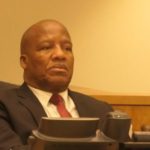 H.E. Jackson Mthembu, Minister in the Presidency, South Africa
H.E. Jackson Mthembu, Minister in the Presidency, South Africa
“Statistics SA has in recent years undertaken substantial work to broaden our understanding of poverty in the country. In conjunction with monetary measures we have developed the South Africa Multidimensional Poverty Index (SA-MPI)…employing the Alkire-Foster method…[which] enables us to track changes in levels of poverty over time and gives us evidence as to which indicators contribute most to poverty. It gives us a razor-sharp picture of poverty showing how many people are poor and what deprivations they have in order for our response to be swift and informed.”
“We must use the MPI together with the money metrics as an additional measure by our government to fight poverty. Using these combined tools enables us to gain a better picture to fight poverty.”
“Established less than a decade ago the MPPN is a very important structure in the world’s efforts to fight poverty.”
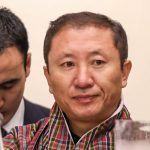 H.E. Tandi Dorji, Foreign Minister, Bhutan
H.E. Tandi Dorji, Foreign Minister, Bhutan
“Bhutan was the second country to officially launch the multidimensional poverty index in 2010 and the first to fully use the Alkire-Foster method… Since then both monetary and multidimensional poverty has reduced drastically.”
“In the last six years, our MPI declined from 12.7 in 2012 to 5.8 percent in 2017.”
“This is largely due to the wise commitment of the royal government over the past decades which has been further guided by the visions of our monarchs. Bhutan provides free healthcare, free education, extensive infrastructure development, and fast economic growth. We also use the MPI for targeted interventions, and also for allocating our scarce resources, using – as we call it – the resource allocation formulae for local governments.”
“Against this backdrop, there are two points to contribute…. First, we, like Mexico and Colombia and other first generation MPI adopters, are ready to complement our original MPI – that reflects acute poverty – with a moderate MPI.”
“Second, Bhutan has a…holistic perspective because of our concept of Gross National Happiness or GNH. Since 2008, our GNH Index has used the MPI methodology and its tools. Yet poverty and well-being and GNH are not the same. When we add to the MPI dimensions of culture, community, environment, governance, time use, and psychological well-being, we see more. And we see this trend gaining traction among our friends.”
“So I propose a Call to Action on Well-being: as the Human Development Reports of the UN reach 30 years and the SDGs reach 5 years, can we seriously explore Measures of Well-being that include and extend beyond MPI? …Using our GNH Index we can see person by person who lacks the conditions for Well-being and how we can improve those. We call also for action to learn together those policies that address subtler aspects of Well-being like social isolation or anxiety or the delicate yet profound topic of spirituality.”
“In an era of rising inequality, let us firmly commit to both ending poverty in all its forms, for everyone, and expanding well-being in all its forms, for everyone.”
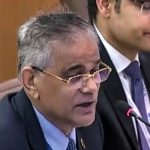 H.E. Shamsul Alam, Member (Senior Secretary), National Planning Commission, Bangladesh
H.E. Shamsul Alam, Member (Senior Secretary), National Planning Commission, Bangladesh
“The Government of Bangladesh recognizes the multi-dimensional nature of poverty and the need to address the problem by adopting appropriate policies and strategies.
“We estimate child MPI first….Why? They make up 47% of the poor and are more susceptible to abuse, exploitation and natural disasters. Many issues linger throughout their lives.”
“We’ll release the child-focused poverty measure and then go on with the process of the National MPI immediately.”
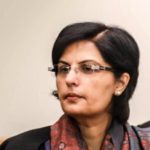 H.E. Sania Nishtar, Special Assistant to the Prime Minister, Pakistan
H.E. Sania Nishtar, Special Assistant to the Prime Minister, Pakistan
“We believe the MPI is highly relevant to the SDGs and related measurements. I am pleased to report that both MPI and SDGs feature prominently in Pakistan’s recently launched umbrella initiative Ehsaas, which aims to address poverty and inequality.”
“11 out of the 17 SDG goals are firmly embedded in the Ehsaas framework.”
“In terms of the metrics, we have used both consumption based estimates as indicators of monetary poverty as well as the MPI as a measure of non-monetary deprivations to establish baselines for the Ehsaas initiative. We note that MPI reporting has been stipulated in SDG 1.2.2 and I’m pleased to convey that as a member of the MPPN, Pakistan will report its MPI metrics as soon as the UN opens the relevant portal, which I believe is scheduled for 22 October this year.”
“We are committed to data disaggregation by gender, by income quintile, and on geographical bases, which we believe is the first step to understand the local drivers of poverty.”
“Our new nationally representative social and living standards measurement survey for 2019 is in the field and is powered for such disaggregation and we will use these data for the new MPI figures which we hope to release by the middle of next year.”
“The Ehsaas framework includes the national strategy for the development of statistics to strengthen the quality and availability of statistics by the Pakistan Bureau of statistics. We would like to ensure independence of statistics so the government has access to a credible and reliable base of evidence which we believe is critical to support the design and evaluation of policies.”
“We believe data and evidence are crucial for decision-making in Ehsaas, because the Ehsaas framework is aimed at those who are most in the need for help – the extreme chronic poor, those who suffer catastrophic risks, orphans, widows, the homeless, the disabled, the jobless, poor farmers, labourers, the sick who risk impoverishment, the undernourished, students from low income backgrounds, poor women and elderly citizens.”
“We believe that Ehsaas is unique, and I say this with humility, because it is the most ambitious poverty-centred umbrella initiative the Pakistan government has ever undertaken with its 134 policies and programme elements. It is both multisectoral as well as multi-stakeholder based. And it is embedded in theory of change, which is reflected in its four pillars: action against elite capture, safety nets, livelihoods and jobs, and human capital formation… The Ehsaas strategy has been released 10 days ago and can be accessed on our website. We invite all of you to comment on this framework and we look forward to our collaboration with the network to share lessons and to learn from all of you.”
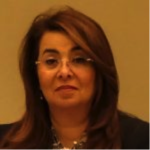 H.E. Ghada Fathi Wali, Minister of Social Solidarity, Arab Republic of Egypt
H.E. Ghada Fathi Wali, Minister of Social Solidarity, Arab Republic of Egypt
“The MPI has a sound methodology to help track progress towards the achievement of SDGs in general and for combating poverty and ultimately monitoring how the different dimensions are interlinked to accelerate progress across the 17 goals of the SDGs. Actually we find it very useful to allow global analysis as well. Not just compare within the country, but also compare between different countries. The disaggregation of data is vital for the equitable analysis of multidimensional poverty. The importance of using the MPI to compare different countries and compare within the same country and within the same region in the country is very useful to us. However, and as the Minister from Chile has mentioned, we still have this political challenge of agreeing what are the indicators and how often we should measure that.” “I still believe that we still need a lot of capacity building within countries and between countries and a lot of sharing information and tools so we can make this an accessible and user-friendly tool so that different countries can use and exchange notes. I find the Network very useful, however we still need extra work to invest in capacity building, developing policy tools and publishing policy notes.”
On the Egyptian programme, ‘Dignified Life’, launched by the Presidency, which is targeting 1000 poorest villages with cross-sectoral policies “The most important element in this initiative is the voice of the people, we collect and listen to the people in the villages… and we listen to their needs. It is very interesting how you can relate the elements and the indicators of the MPI to what people really think is important and is of relevance to them which makes it a true good governance tool, not just a measurement tool, not just a policy tool, but a good governance tool because there is this element of partnership and this element of participation of the people.”
“I do congratulate the different countries who have published their MPI reports. We are working on this multidimensional MPI with great enthusiasm, with great interest in making it a national tool for Egypt. We are still at the level of building the capacity and coordinating with the Ministry of Planning, the Ministry of Finance, because this is not the job of one ministry, it has to be a consensus at the political, at the highest level, and there has to be communication and understanding for the people at the village level of what we are measuring and why we are measuring it.”
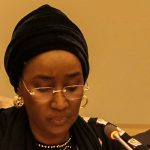 H.E. Hajiya Sadiya Umar Faruk, Minister for Humanitarian Affairs, Disaster Management and Social Development, Nigeria
H.E. Hajiya Sadiya Umar Faruk, Minister for Humanitarian Affairs, Disaster Management and Social Development, Nigeria
“In his first time in office between 2015 and 2019, the government successfully empowered more than five million people out of extreme poverty through its national social investment programme. Following this success the President announced the plan to empower 100 million people out of poverty in the next 10 years. He declared that by the end of eight years, we will have laid the grounds for lifting 100 million Nigerians out of poverty. This outcome will fundamentally shift Nigeria’s trajectory and place us among the great nations. This aspiration takes into cognizance the country’s current estimated population of about 200 million people and following this announcement – the 100 million out of poverty mandate kicked off with the establishment of a Ministry to coordinate these multi-sectoral efforts. That is the Ministry of Humanitarian Affairs, Sustainable Management, and Social Development. The Ministry will coordinate with different government agencies, donor organisations, and private investors to shape policies and drive real impact.”
“With the support of the President we use the MPI data to foster governmental accountability to citizens by indicator tracking of ministerial performance.”
“Also we will support and work closely with the national bureau of statistics to conduct regular multidimensional poverty measurements alongside monetary measures at national and subnational levels to understand our true poverty status and use findings to continue shaping public policies.”
“We will create a national and state poverty map/tracker to provide a vivid representation of progress towards our end poverty goal.”
“In collaboration with the Ministry of Finance, Budget and National Planning, we will use MPI data to improve budget allocations by sector and State, with the aim of better targeting beneficiaries of the 100 million Out of Poverty mandate.”
“We will facilitate a bi-annual multi-stakeholder, multisector National Roundtable on the reduction of Poverty and Inequality.”
“These strategies demand a multilateral approach where the three arms of Government: Executive, Legislative and the Judiciary, work towards this common goal. Achieving the SDGs and specifically, SDG 1: Eradicating extreme poverty by 2030, also calls for regional and global efforts.”
“You will agree with me that the road to SDG 2030 looks bright and promising given today’s conversation. My optimism is premised on the assumption that when Nigeria extends its hand to support and request support in regards to the 100 million Out of Poverty mandate, the MPPN, UNDP, donors, countries, regions, and the good people of the world, will rise to the occasion, and act in partnership as we jointly seek to end poverty and reduce inequality. Our destinies are linked; the goal is common; and time can’t wait. Let us join hands together to make this happen.”
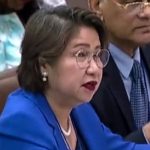 H.E. Rosemarie G. Edillon, Policy and Planning Group, National Economic and Development Authority (NEDA), Republic of the Philippines
H.E. Rosemarie G. Edillon, Policy and Planning Group, National Economic and Development Authority (NEDA), Republic of the Philippines
“We fully subscribe to the ambition of Goal 1 of the 17 Sustainable Development Goals (SDGs) which calls for addressing poverty in all its forms, in all its dimensions. This is where the Multidimensional Poverty Index (MPI) comes in handy. In addition to income-based measures, MPI enriches our poverty analysis by highlighting the deprivations of the poor.”
“The initial set of the Philippine MPI results released in November 2018 covers 4 dimensions – namely, (1) education, (2) health and nutrition, (3) housing, water and sanitation, and (4) employment. There are 13 indicators under these dimensions.”
“Preliminary results show that, in 2017, there were 17.3 percent of Filipinos who were multidimensionally poor or were deprived in at least one third of the indicators, an improvement from the 23.9 percent in 2016.”
“Digging deeper, initial results indicate that education has the largest contribution to the overall multidimensional poverty index”
“These initial results sent ripple effects to the public education sector…. Consequently, there is now a call for greater budget allocation.”
“We intend to fully utilize the MPI to inform policy and resource allocation. Out next MPI will be based on our Family Income and Expenditure Survey.”
“As we pledge to leave no one behind, we have to get better at identifying where the poor have serious deprivations. Hence, we support the adoption and development of alternative poverty measures such as the MPI.”
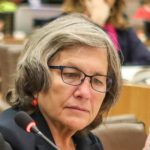 H.E. Trudi J. Renwick, Assistant Division Chief, Economic Characteristics, Social, Economic and Housing Statistics Division, US Census Bureau
H.E. Trudi J. Renwick, Assistant Division Chief, Economic Characteristics, Social, Economic and Housing Statistics Division, US Census Bureau
“Last May the US Census Bureau published its first report on multidimensional deprivation. Using data from our American community survey the report looks at six dimensions: standard of living, education, health, economic security, housing quality and neighbourhood quality. The report found that 15.4% of the US population in 2017 faced two deprivations. The majority of these were characterised as in poverty using our pre-tax unidimensional income poverty measure. But, there was a considerable part of the population, 4.6%, who were not income poor, but faced deprivations in two other areas. At the state level, there were 20 states and the District of Columbia where the MDI was higher than the official poverty rate. There were 16 states where the official poverty rate was higher, and 14 where the differences were not statistically significant. Decomposing the MDI we found that standard of living and housing quality contributed the most to the measure particularly for children and working age adults. Looking at race and ethnic origin, blacks and hispanics were over-represented in their shares of multidimensional deprived population relative to their share of the overall population. Our research into this exciting new approach will continue. Dr Glassman is currently working on implementing a conceptually similar measure of multidimensional poverty in other household surveys.”
Development Partners
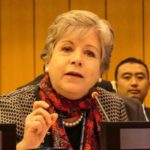 Ms. Alicia Bárcena, Executive Secretary, UN – Economic Commission for Latin America and the Caribbean
Ms. Alicia Bárcena, Executive Secretary, UN – Economic Commission for Latin America and the Caribbean
“Monetary policies are useful but multidimensional poverty does give you a sense of deprivations of housing, education and health”
“We have to improve the metrics. We have to make sure we are using rigorous systems to allow us to see trends”
“We see two sets of countries (1) Uruguay where public policy effectively invests in labour policies which are linked in income (2) Costa Rica with effective investment in social policies.”
“We need to collaborate to build a measure that includes multidimensional comparison in a regional index.”
“If we improve the metrics, we can have a policy design that can be better, because monetary poverty, the way we measure it, is about income, but multidimensional poverty is entering another issue which is public policy on housing and health, which not necessarily provided by income only, so it is important that we distinguish these two when we formulate public policy.”
H.E Ahmed Aboul Gheit- Secretary General of the League of Arab State. Delivered by H.E Hayfaa Abu Ghazaleh, Assistant Secretary –General, Head of Social Affairs Sector.
Due to time constraints we were unfortunately unable to hear the statement from the League of Arab States in full. Please find it here.’
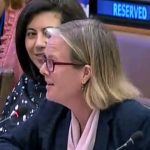 Ms. Carin Jämtin, Director General Swedish International Development Cooperation Agency
Ms. Carin Jämtin, Director General Swedish International Development Cooperation Agency
Due to time constraints we were unfortunately unable to hear the statement from Sida in full.
“We are proud partners of OPHI and that is because measuring poverty must be about more than money.”
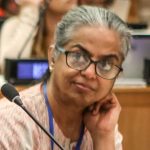 Ms. Vidhya Ganesh, Director of Division of Data, Analytics, Planning and Monitoring (DAPM), UNICEF
Ms. Vidhya Ganesh, Director of Division of Data, Analytics, Planning and Monitoring (DAPM), UNICEF
Due to time constraints we were unfortunately unable to hear the statement from UNICEF in full.
According to the global MPI, “The numbers are really staggering, 663 million children live in multidimensionally poor households and one third of them are under the age of five. This is pointing at how to use the measurement for policy programming and governance. I think that we have a real task ahead of us, and we are very happy to collaborate with the MPPN network.”
Remarks from the floor
H.E. Alejandro Murat Hinojosa, Governor of Oaxaca State, Mexico
H.E. José Aguilar, Executive Director, Horizonte Positivo, Costa Rica
Recording of the session here.
Global Sustainable Development Report: here.
[1] The SDG Summit is the first UN summit on the SDGs since the adoption of the 2030 Agenda in September 2015. Its purpose is for Heads of State and Government to follow up and comprehensively review progress in the implementation of the 2030 Agenda for Sustainable Development and the 17 Sustainable Development Goals (SDGs).












Recent Comments